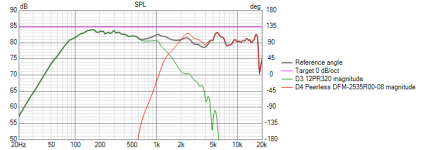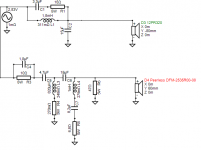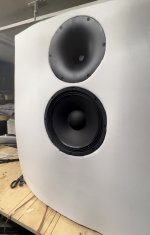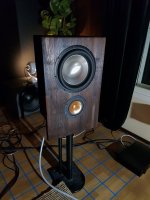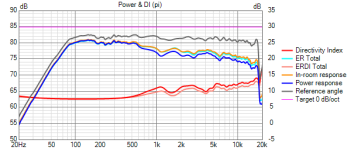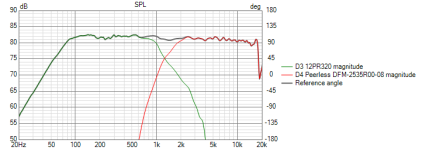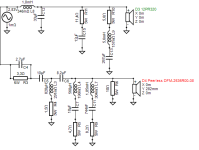ST260B was not flush mounted.
Thats fine driver! Is it available for hobbyists somewhere? seems to be out of stock / sold in big quantities what I found (Europe).
Heres waterfall from straight ahead. Let me know if you need different and Ill post itOr a bit higher.
Do you have a waterfall to show resonances (e.g. 5.5kHz)?
I bought them about year ago for Rese66´s Asathor when they still were available, but then got ST260B printed and finally proceeded with them.Thats fine driver! Is it available for hobbyists somewhere? seems to be out of stock / sold in big quantities what I found (Europe).
Heres some testing, used Zvu`s sketch as starting point. There is zip with all Vcad files if anyones interested.
you should notch this 5k/6k rigth in the sibilance area with a RLC or a // notch...
Happy to see this 🙂
Happy to see this 🙂
Diyiggy: "you should notch this 5k/6k rigth in the sibilance area with a RLC or a // notch..."
I will try this! I have also Minidsp and testing would be easier with it, but maybe I have wrong assumptions but have anybody else noticed that many builders trying active DSP solutions have returned to passive crossovers after trying their best? Do those active solutions need more skills to sound "analog" / passive like easier sound?
Puppet: "Oceanw ... look forward to a post about your build. Looks like it'll be real nice!"
Thanks! I will test first few other CD´s in hand (RCF N481 and B&C DE250) and how they compare to DFM-2535R00 in ST260/B.
I also made "fake flush mount" from foam and its thickness matches ST260B. Have to attach it properly (it fits perfectly unlike in attachment pic concerning ST260B) and take measurements with DFM-2535R00 again. Maybe in best case there happens something to that 5,5-6Khz bump?
I will try this! I have also Minidsp and testing would be easier with it, but maybe I have wrong assumptions but have anybody else noticed that many builders trying active DSP solutions have returned to passive crossovers after trying their best? Do those active solutions need more skills to sound "analog" / passive like easier sound?
Puppet: "Oceanw ... look forward to a post about your build. Looks like it'll be real nice!"
Thanks! I will test first few other CD´s in hand (RCF N481 and B&C DE250) and how they compare to DFM-2535R00 in ST260/B.
I also made "fake flush mount" from foam and its thickness matches ST260B. Have to attach it properly (it fits perfectly unlike in attachment pic concerning ST260B) and take measurements with DFM-2535R00 again. Maybe in best case there happens something to that 5,5-6Khz bump?
Attachments
for proper crossover full spin is needed or you could try trick from napilopez but it is a rough way:Heres some testing, used Zvu`s sketch as starting point. There is zip with all Vcad files if anyones interested.
https://www.audiosciencereview.com/...th-rew-and-vituixcad.21860/page-2#post-752673That translates to H (0,30,60,90, 180) and V (+/-30, 60, 90) for a typical speaker with vertically aligned and horizontally symmetrical drivers.
I really duno for DSP as I never tried, I like passive and mechanichal cause more elegant but I am looking into such a solution at least for the design process as advised by experienced guys here. Copper became expensive and for sure clicking is faster than soldering when experimenting. Then nothing should stop you to translate it into a passive solution. But plates are seductive for the bass unit to setup into each own room (bass boost if needed).
In the OSMC thread from Mathias you should find the FRD and ZMA of the 12PR320 made by Mbrennwa (his member id) in 77 liter if I remember correctly, this is how I simed the filter above... came strangly close to the impedance curve what is showing Tony Gee from HumbleHomeMadeHifi. Anything between 77 liers and 113 litters should be fine ; the Vas of the neww datasheet is 113 liters.
My limited understanding with active and DSP is than boosting dips are arming for the driver and ears while notching peaks is ok when applying EQ.
I also found that the quality fo the numeric playback has an important role, few multichannel seems theorically good enough to suit my own taste : MiniDSP Flex 8 (the easier to work with if I understand correctly and it has a power volume knob), Topping multichannel DAC (just a DAC), OKTOReasearchPro8 (I'd like to have this but expensive for my wallet) or HypexPlate DSP module (scandalous Skandinavian prices for my monney).
The passive filter from Tony Gee doesn't seem that complicate but the unit used HF108 seems smoother than yours and when on the baffle the horn should exhibit perhaps a more ragged response. >= 1200 hz cut-off seems wize, not as I planned with lower cut-off with the BMS (900 hz as the lowest cut-off; many people found the sound of horn/1" combo a little hard here. But sure the Mabat horn plus the BMS are more tolerant there... one has to listen to it for real to know and I am way to slow on my projects to help that much alas).
I think it is ok to stay passive, a notch is easy to do and you will know more after in room measurements and hearing tests 🙂 . Looking forward too to see your progress.
In the OSMC thread from Mathias you should find the FRD and ZMA of the 12PR320 made by Mbrennwa (his member id) in 77 liter if I remember correctly, this is how I simed the filter above... came strangly close to the impedance curve what is showing Tony Gee from HumbleHomeMadeHifi. Anything between 77 liers and 113 litters should be fine ; the Vas of the neww datasheet is 113 liters.
My limited understanding with active and DSP is than boosting dips are arming for the driver and ears while notching peaks is ok when applying EQ.
I also found that the quality fo the numeric playback has an important role, few multichannel seems theorically good enough to suit my own taste : MiniDSP Flex 8 (the easier to work with if I understand correctly and it has a power volume knob), Topping multichannel DAC (just a DAC), OKTOReasearchPro8 (I'd like to have this but expensive for my wallet) or HypexPlate DSP module (scandalous Skandinavian prices for my monney).
The passive filter from Tony Gee doesn't seem that complicate but the unit used HF108 seems smoother than yours and when on the baffle the horn should exhibit perhaps a more ragged response. >= 1200 hz cut-off seems wize, not as I planned with lower cut-off with the BMS (900 hz as the lowest cut-off; many people found the sound of horn/1" combo a little hard here. But sure the Mabat horn plus the BMS are more tolerant there... one has to listen to it for real to know and I am way to slow on my projects to help that much alas).
I think it is ok to stay passive, a notch is easy to do and you will know more after in room measurements and hearing tests 🙂 . Looking forward too to see your progress.
My last try with DSP was FAST with Alpair 10.3 and L26RO4Y. Used Saffire Pro 40 and Lupisoft Ekio. Results were quite good but my skills with Vcad were much worse than now, and im still taking baby steps 😀I really duno for DSP as I never tried, I like passive and mechanichal cause more elegant but I am looking into such a solution at least for the design process as advised by experienced guys here. Copper became expensive and for sure clicking is faster than soldering when experimenting. Then nothing should stop you to translate it into a passive solution. But plates are seductive for the bass unit to setup into each own room (bass boost if needed).
In the OSMC thread from Mathias you should find the FRD and ZMA of the 12PR320 made by Mbrennwa (his member id) in 77 liter if I remember correctly, this is how I simed the filter above... came strangly close to the impedance curve what is showing Tony Gee from HumbleHomeMadeHifi. Anything between 77 liers and 113 litters should be fine ; the Vas of the neww datasheet is 113 liters.
My limited understanding with active and DSP is than boosting dips are arming for the driver and ears while notching peaks is ok when applying EQ.
I also found that the quality fo the numeric playback has an important role, few multichannel seems theorically good enough to suit my own taste : MiniDSP Flex 8 (the easier to work with if I understand correctly and it has a power volume knob), Topping multichannel DAC (just a DAC), OKTOReasearchPro8 (I'd like to have this but expensive for my wallet) or HypexPlate DSP module (scandalous Skandinavian prices for my monney).
The passive filter from Tony Gee doesn't seem that complicate but the unit used HF108 seems smoother than yours and when on the baffle the horn should exhibit perhaps a more ragged response. >= 1200 hz cut-off seems wize, not as I planned with lower cut-off with the BMS (900 hz as the lowest cut-off; many people found the sound of horn/1" combo a little hard here. But sure the Mabat horn plus the BMS are more tolerant there... one has to listen to it for real to know and I am way to slow on my projects to help that much alas).
I think it is ok to stay passive, a notch is easy to do and you will know more after in room measurements and hearing tests 🙂 . Looking forward too to see your progress.
Ill post more as there is progress, Im curious see how those different drivers work in ST260B and how that foam flush mount will affect. After finding best driver from my own drivers Ill get to the woofer choices.
Attachments
Thanks sheeple. Ill measure drivers with more simple way but have to try this method when there is more progress and drivers chosen & final baffle done. More sturdy turning table is needed, which also allows vertical measurements with flipped bigger speaker. Now I use just simple lazy susan style plywood rig and have always made or used different kind of temporary risers depending on project.for proper crossover full spin is needed or you could try trick from napilopez but it is a rough way:
https://www.audiosciencereview.com/...th-rew-and-vituixcad.21860/page-2#post-752673
You should use what you're most comfortable with that lets you get the job done.I really duno for DSP as I never tried, I like passive and mechanichal cause more elegant but I am looking into such a solution at least for the design process as advised by experienced guys here.
Many who design without measurements (or in spite of them) like the quick swap of the DSP... but passive is just as capable of achieving the end goals otherwise. It helps to have the right tools, for example you can use crocodile leads rather than solder, be set up with a simulator, use an equaliser for testing.
I have the HF10AK and 12PR320 aswell. Do you cross them active or passively? If passively would you mind sharing the schematic?I use the Faital 12PR300 and the 12PR320 for moderate level PA. The woofers have a very smooth and linear breakup region above 1KHz which makes it easy to crossover to a 1" CD on an approx. 12" wide horn. These sorts of designs are meant to use the woofer beyond its pistonic range, because that is also the range where the directivity increases due to cancellation.
You want to balance the smoothness of the directivity transition and woofer breakup modes, compression driver distortion to get an optimal compromise. No single parameter will be textbook perfect. Higher-order XO slopes help too.
I cross these Faital woofers to a Faital HF10AK on a QSC clone at 1300Hz LR4 and the sound is really quite excellent, either for PA or in my living room. But at home a lower crossover @ 800Hz would probably sound very nice too, as long as you aren't pounding the compression driver too hard. I would be more concerned with finding a 1" horn that sounds good in the higher octaves.
I would be more concerned with finding a 1" horn that sounds good in the higher octaves.
Isn't it the other way around > "Finding a horn that sounds good in the lower part of the passband"?
Unless you refer to beaming and/or diffraction/reflection, which are negligible with modern horns/waveguides.
Some progress after break.
This was best I could do with 12PR320 and DFM2535 at ST260B.
Real-world measurement showed some resonance at approx 1Khz. I have to study it more, it might be from waveguide.
Waveguides were printed in two parts and I should have been more careful before assembling glued waveguide to enclosure: the joint surfaces were not in same thickness/level and waveguide made crackling sound when screws were tightened.
I will make some reinforcement with epoxy at the backside of waveguides and sand all joint surfaces to avoid this at the final phase.
Next I measure Peeless SLS12 and model it with Vcad. It might be a vain hope to get that work at approx 1200Khz XO freq.
But im tempted to still try it, SLS12 would offer F3 of 50Hz in my sealed 80 liter enclosures. Goal of this this project is for home theater (LCR) and they will be on wall.
This was best I could do with 12PR320 and DFM2535 at ST260B.
Real-world measurement showed some resonance at approx 1Khz. I have to study it more, it might be from waveguide.
Waveguides were printed in two parts and I should have been more careful before assembling glued waveguide to enclosure: the joint surfaces were not in same thickness/level and waveguide made crackling sound when screws were tightened.
I will make some reinforcement with epoxy at the backside of waveguides and sand all joint surfaces to avoid this at the final phase.
Next I measure Peeless SLS12 and model it with Vcad. It might be a vain hope to get that work at approx 1200Khz XO freq.
But im tempted to still try it, SLS12 would offer F3 of 50Hz in my sealed 80 liter enclosures. Goal of this this project is for home theater (LCR) and they will be on wall.
Attachments
- Home
- Loudspeakers
- Multi-Way
- 12" & >=90° Horn : where to cross over?
